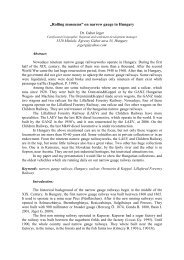'Representing Difficult Pasts within Complex Presents ... - T2M
'Representing Difficult Pasts within Complex Presents ... - T2M
'Representing Difficult Pasts within Complex Presents ... - T2M
Create successful ePaper yourself
Turn your PDF publications into a flip-book with our unique Google optimized e-Paper software.
asked to move out, consequently demonstrating that controversies of property and ownership run into the<br />
20<br />
present in Lwandle. Opposite Hostel 33 are other, now converted,<br />
hostel buildings that families live in.<br />
Figure 9 Interior of Hostel 33, Lwandle<br />
The Worker’s Museum, alternatively sited in the centre of<br />
Johannesburg, not in a township, was also a hostel for migrant<br />
labourers. For the museum exhibition, the City of Johannesburg<br />
assigned an outside design team 27 - the outcome being a more<br />
‘glitzy’ exhibition providing a history of migrant labour through the<br />
use of video, sound, installations and photographs. The emphasis,<br />
again, was on people’s experience. For example one of the rooms<br />
depicted a rural backdrop with photographs of migrant labourers in<br />
the foreground, suggesting both the urban and rural origins of these<br />
persons. The living quarters were not as originally constructed, but were painted a bright red, with less<br />
emphasis on the ‘authenticity’ of the past, and more on design aspects - certainly not created to replicate a<br />
sense of being ‘lived in’ as in Hostel 33 of Lwandle Migrant Labour museum.<br />
The curator, Anne-Kristin Bicher, pointed out that the museum does not specifically concentrate<br />
much on the actual journeys to and from the workers’ compound through public transport networks, such<br />
as the railways. However, there were references throughout the museum displays that referred to aspects<br />
of transport and mobility. For example one of the video displays portraying memories of people arriving<br />
in the worker’s compound, had one narrative filmed on a train. Furthermore, one large photograph, on the<br />
wall outside, portrayed people apparently having just arrived from the train station in Johannesburg,<br />
carrying their luggage across the street.<br />
The Workers’ Museum timeline contrasted with the James Hall Museum’s timeline, being not<br />
one of coca cola and Barbie dolls but one which focused specifically on a South African historical<br />
apartheid and resistance context. The museum also contained artefacts people brought and made at the<br />
hostel, and apparently the compound was a site of creativity for performances and music in the past. Also<br />
of interest, possibly in relation to recent issues of xenophobic violence in 2008 and since, was a map<br />
27 This has its drawbacks - one artefact exhibited inside a glass case had fallen down but the museum had<br />
not managed to get hold of the designers to fix it and the exhibit had been broken for a long time




